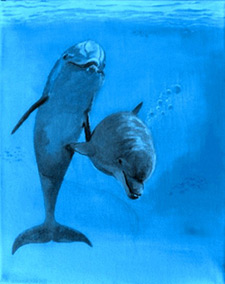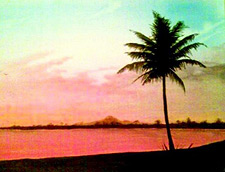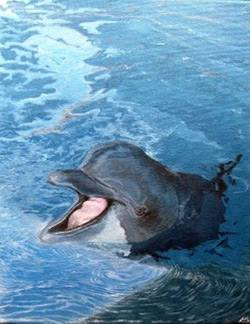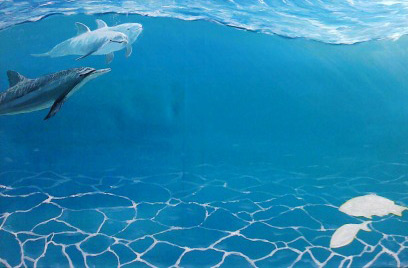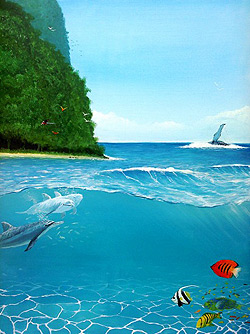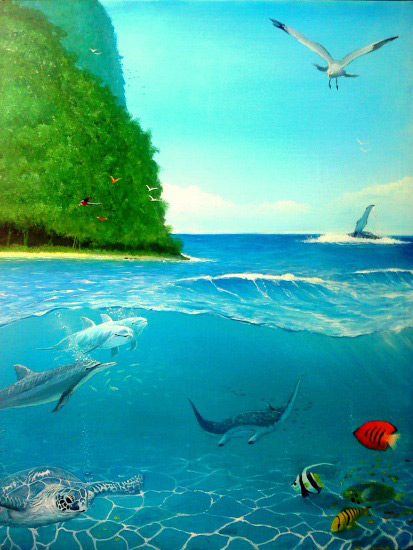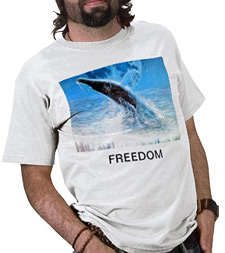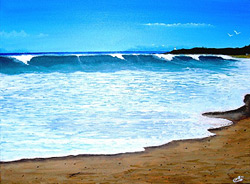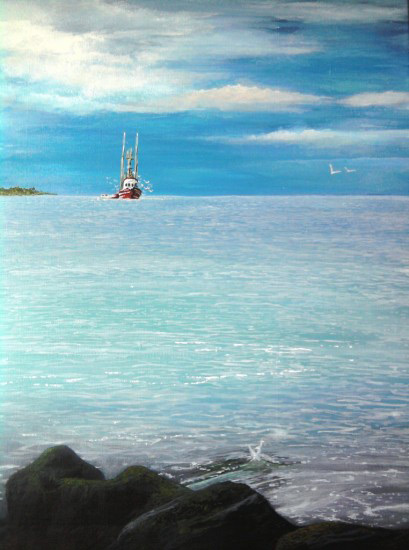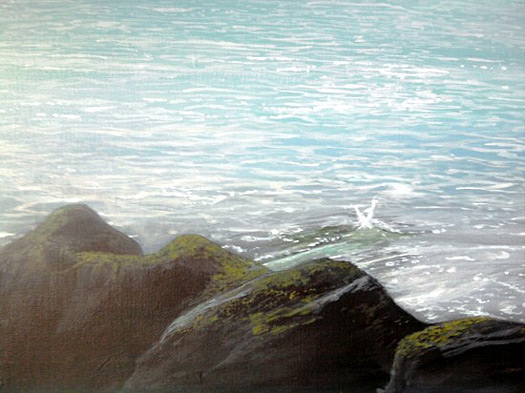Ocean Art by Alan Minshull
The ocean art of Alan Minshull teems with sea life: dolphins, sharks, crabs, stingrays, sea gulls, and colourful rainbows of fish can all be found floating, splashing, flying or swimming in his detailed ocean paintings.
When you look at Alan's work, you can see the waves crashing against the shore, spraying white misty foam into the air. You could swear you also hear the roar of the ocean. Don't look too closely or you might get wet!
Alan's work is as inspiring as the ocean itself, capturing not just the sights but also evoking the sounds, smells and sensations of standing on the shore or diving underneath the waves, gazing in awe at the sea life all around you.
Alan was kind enough to grant Art-is-fun.com this exclusive interview. Find out what inspires Alan and follow along as he explains how he created one of his beautiful ocean paintings.
How long have you been an artist?
I’ve been an artist now for over 25 years. Ever since I first picked up a pencil and paintbrush when I was at infant school (kindergarten) aged 4 and I still remember to this day my first drawing. It was for road safety and came first in a fun contest. I remember winning a basket of candy to take home with me. That was one of the happiest days of my life.
Did you go to art school, or are you self-taught?
I went to college at age 18 years old in 1985 and studied Art & Design for a year, gaining a National Diploma (merit grade). Although the course was to help broaden my skills at drawing and painting, I ended up halfway through specializing in fantasy art and cover albums and logos.
Later on I attended a graphic art course (1990) and it was there that I learned about realism and capturing detail. This education or training ended up with me finding a full time job in a graphic art studio, where I was taught how to use computers to create logos and backgrounds for businesses.
What is your favorite medium, and why?
My favourite medium is acrylic because of its density and vivid colour and also its quick drying quality. When I started out painting, I used watercolours and found them wonderful to work with but I wanted a deeper, richer density to the scenes and subjects that I enjoyed working upon. It was a little later that someone introduced me to acrylics and I have never looked back.
What are some challenges of working in acrylics?
The trick with acrylics is to not let it dry out while using it. The quick drying time puts many people off using it but there are plenty of retardants (slows down drying time), and even ones that you can quite easily make on your own that makes this problem obsolete. I use clear cough mixture added to water, which has essentially almost the same ingredients as a retardant that you would purchase in an art store, although much more expensive.
What size range do you work in?
The largest painting I have worked upon so far is 40in x 32in and is ‘Tropical Ocean’ (latest work) yet I have worked upon much larger pieces while at college in 1985. This was a huge replica of the ‘Bat out of Hell’ album by Meatloaf. However I also do much smaller pieces and the smallest is 5in x 8in and just featured a solitary seashell on a shore. In the past I have also been asked to draw for friends, things like wizards and dragons and also Celtic knotwork and band logos.
When (and why) did you start getting interested in painting Ocean Art?
In 2005, after working in a full time job I decided to take a vacation to a most beautiful part of Southern England called ‘Cornwall’. I booked myself onto a 3 week surfing course at The Home Surf Lodge (now Escape Surf School). While down there, one morning at 5am I grabbed my board and headed out on a particularly beautiful warm summer morning to Fistral Beach (famous for surfing) and sat on my longboard waiting for waves. Not long after I turned my head and happened to see two gorgeous free dolphins swimming or surfing within a beautiful blue wave rushing into shore. I knew from that moment on how wonderful our oceans and seas are and ocean art was since then ingrained into my heart and mind. I spent a whole year there working at the surf school, recording memories on paper and with my camera.
Can you walk us through the steps you take to create one of your ocean paintings?
How I painted ‘Tropical Ocean Blue’ in Stages.
Stage 1 - I started off my seascape here by painting a flat solid color blend of cerulean blue, Sky blue, white, and a touch of bright yellow to achieve a vivid aqua/turquoise mix. If you find that it looks to dark, just add more white and dont be afraid to paint the white onto the still wet canvas and blend it in. The lower half of this sea, is just the same but with not too much white added.
I then painted in a slightly darker line to mark out where I wanted my surface water line to be.
The highlights on the water are made by mixing a little sky blue with some white. Use a fine paintbrush and just follow the direction the water is going.
Stage 2 - Next, I began painting in the movement and waves. Mix up white with the tiniest drop of sky blue, and paint lines always following the direction the water is flowing again. The wave itself began as a single white line, with a touch of darker blue shading than the background just under the white and blended out at the bottom. Then to this I added little foam pattern lines using that white blue mix, following the direction of the wave. Highlights on the surface will get smaller the further you reach to the horizon.
Here's a close-up of Alan's painting in progress.
Note how he blocks in the fish in the lower right with white paint before painting in their colors and details.
Stage 3 - When the surface was complete, I began working on the sea floor patterns. This looks difficult but really is the easiest. All you have to remember is that the shapes must meet or join at every edge, and almost must be diamond or oval shaped, to represent the light gleaming down from the surface of the sea. Where the shapes join, paint an extra white dab of white paint there and blend this out along each connecting line. This gives it extra highlights. Add a little blue to your white mix the further you work into the distance. The white sunlight shimmering through the surface on the top right, was created with a little white paint on a large brush. Just drag the paint downward diagonally using the flat edge of the brush.
The finished painting:
Who are some artists you admire?
I really love the work of wildlife and conservation artists such as Wyland and Scott Christensen. They have an ability to capture the imagination with their ocean scenes. Wyland loves painting undersea wildlife and deep blue spaces teeming with fish, while Scott paints beautiful long beaches glimmering with sunlight and iridescent waves. I am happy enough to know both of them as friends, in particular Wyland who recently made me a member of The Ocean Artists Society - amongst some of the top marine and ocean artists in the world.
Can you tell us about some of your conservation efforts?
Alan's art is available on shirts & other items here.
Some of the conservation work that I do involves beach clean ups, where groups of the general public get involved in picking up and cleaning up local beaches for The Marine Conservation Society. Every small act, no matter how insignificant it may seem at the time has a huge impact upon our earth. I also paint for conservation too, which involves sending once every so often an original painting to The Ocean Artists Society. They then sell prints of this and the money goes straight towards conservation costs.
Do you have any tips or advice for people who would like to start painting ocean art?
One of the best tips that I have for people who wish to begin painting oceans is to work in layers. Once you have placed down a solid blue, you’re going to find it tricky to work into it and realism, if thats what you are aiming at, will be hard to achieve unless you begin in layers. I always begin my oceans with an emerald green layer to begin with and work in many lighter shades of blue on top of this. Each layer brings my ocean more and more to life.
Splashes, sea spray and mist are real easy to achieve. Just grab a toothbrush and white paint (Chinese white and also metallic are both used). Coat your toothbrush with Chinese white and literally flick it on top of your wave or near rocks where you want the water to crash and splash. Then wash the brish and apply some metallic white and a little water, and do the same thing on top. This will give you heavy splashes and light misty splashes but most of all look realistic!
Close-up of Alan's painting, showing the detail in the rocks and water
Thanks Alan for such a great interview!
You can see more of Alan's ocean art here: https://fineartamerica.com/profiles/alan-minshull.
Alan's ocean art can be purchased on t-shirts, greeting cards, hats, mugs and other items in his Zazzle shop: www.zazzle.com/alanminshull.




